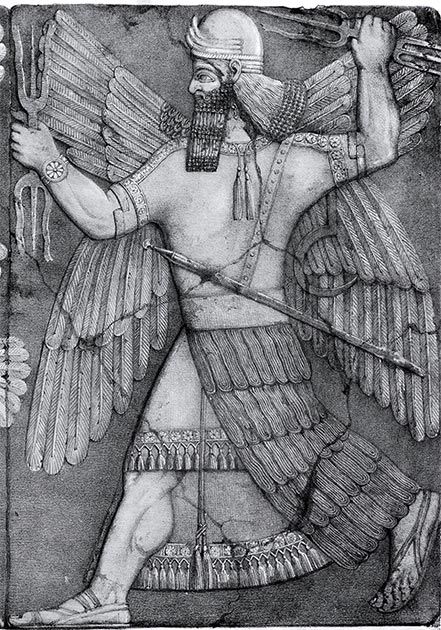
Ritual Site Dedicated to Mesopotamian War God Discovered in Iraq
Archaeologists working in Iraq have made an intriguing discovery. They have found a sacred area that was dedicated to a Mesopotamian war god. The site is up to 5,000 years-old and is in one of the earliest known cities. This find is allowing researchers to better understand the people and the culture of Mesopotamia, the purported ‘cradle of civilization’.
The find was made by a team of experts working on the Tello Ancient Girsu Project, which has been overseen by the British Museum. “Tello, the ancient Sumerian Girsu, is one of the earliest known cities of the world” according to ASOR.
This site has been intensively investigated in the past, during which many important Sumerian remains and artifacts were uncovered. The focus of the most recent archaeological investigations has been centered on the sacred district of Girsu, known as Uruku, where there was a temple to the Mesopotamian war god, Ningirsu.

At the site of ancient Girsu, in southern Iraq, is a temple built for the war god Ningirsu. (British Museum / ASOR)
Ritual Pit Found in the War God’s Temple
The team was able to develop a virtual reconstruction of the site and this greatly assisted them in their dig. ASOR reports that “declassified 1960s Corona spy satellite images and modern drones” were used to create digital maps of the temple and the surrounding area.
This allowed them to create a virtual reconstruction of the site and enabled them to excavate the location in a more systematic way. Since 2018 the team has been excavating walls, some decorated with cones inscribed with magical spells. The temple to Ningirsu was regarded as one of the most important at the time, according to ancient sources.
- Ancient Mesopotamia and the Rise of Civilization
- 4,000-Year-Old Lost Mesopotamian City Discovered in Iraq
- Enki: The Epic Mesopotamian Water God Who Saved Humanity

Excavating inscribed in situ cones. The cones, found at the war god’s temple, are inscribed with magical spells. (British Museum)
During 2019, the archaeologists unearthed a sacred or cultic area that is up to five millennia old. It was almost certainly used for ritual procession, religious feasting, and sacrifices. They also found some 300 artifacts such as cups, bowls, and vessels, that were probably used in the ceremonies or rituals. Sebastian Rey the director of the project and Tina Greenfield a zooarchaeologist told Live Science that the artifacts were all found “within or near a ‘favissa’ (ritual pit) that was 8.2 feet (2.5 meters) deep”.
Offering to Other Gods Found
One of the more important items uncovered was a bronze bird, probably a duck, with eyes made of shell. Rey and Greenfield told Live Science that this object was probably dedicated to “Nanshe, a goddess associated with water, marshlands, and aquatic birds”. Also found was a fragment, possibly from a vase, that bore the name of Ningirsu.
Live Science reports that Rey and Greenfield believe “that the cups and goblets they found were probably used in a religious feast before being ritually discarded in the pit”. Also recovered from the pit was a large number of bones from both wild and domesticated animals.
These animals had most likely been sacrificed and possibly consumed at ritual feasts. Archaeologists also found ash that came from large ceremonial fires.
Religious Procession and Feasting
The researchers believe that the cultic area was in use during the Early Dynastic period (2950-2350 BC). Rey and Greenfield told Live Science that “according to the cuneiform texts religious festivals took place where the population of Girsu gathered to feast and honor their gods”. Clay tablets, uncovered at Girsu, describe the cultic practices that took place in the temple.
In one account, there was a religious procession that culminated in feasting that was held twice a year in the cultic area. This was held in honor of Ningirsu, the son of Enil the chief god in the Mesopotamian pantheon.

Ningirsu, also known as Ninurta, the ancient Mesopotamian war god. (Katolophyromai / Public Domain)
It appears that a religious procession began in the center of Girsu and after traversing its territory, it arrived at a location known as Gu'edena. What happened here is not known but the procession would later return to the city.
The project is continuing to investigate Girsu and the recent findings will be published in due course. A paper on the discoveries was presented by the researchers to the American Schools of Oriental Research (ASOR) annual meeting in 2019.
The Tello Ancient Girsu Project also aims to preserve the archaeological site. In the past it has helped to train local Iraqis in the interdisciplinary skills needed to preserve their archaeological heritage.

Excavation training at the war god’s temple site. (Tello-Girsu Project, Iraq Scheme, The British Museum)
Top image: Ritual site - cultic platform found under the war god’s temple. Source: British Museum.
By Ed Whelan
















Comments
Wonder if the spells written on the site are normal mesopotamian protective spells (spells warding off evil spirits, natural disasters and those of bad intention) or something totally new
In the earliest records, he was a Ruler or Lord of agriculture and healing,
I do not use the word God as he was never considered to be God
Terming him a God is a method used by the early Christians to prove to the minions that the previous religions are false as there is only one God, you see!